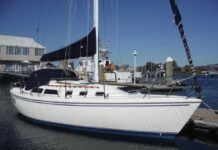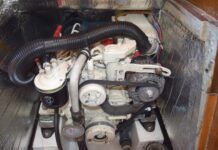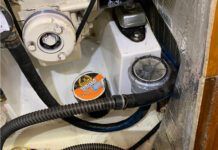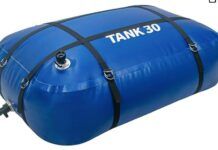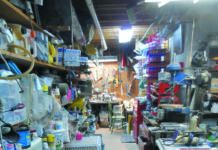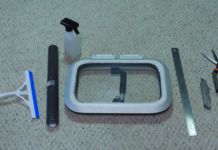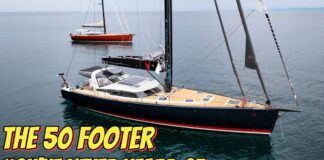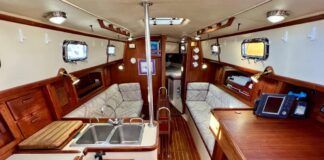The demand for marine air-conditioning (A/C) continues to increase. Once found primarily on medium to large boats, systems suitable for even the smallest cabins are now available. While A/C equipment is connected to shore power whenever possible, or gensets, some of the small systems can be powered from portable, on-deck, gasoline generators or from a 12VDC power source. Air-conditioned comfort can be enjoyed on virtually any size boat.
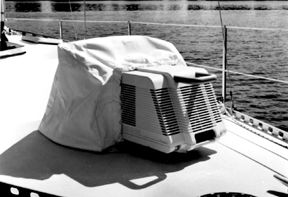
Air-conditioning systems do not create cold; rather, they transport heat from the space to be cooled to a place external to the cooled area. Although a number of different heat transport systems are in common use for terrestrial and aircraft air-conditioners, virtually all marine air-conditioners use electric motor-driven refrigeration compressors. Land-based A/C systems usually transfer heat into the atmosphere while marine air-conditioners deposit the heat in seawater.
Marine A/C equipment may be classified in three groups: self-contained direct expansion, split direct expansion, and chilled water. Although there are no hard and fast rules, most boats less than about 50-60 feet use self-contained direct expansion equipment. Larger vessels usually use either split direct expansion or chilled water systems.
Self-contained direct expansion systems are similar to the common window A/C unit. They cool by moving air over a surface (the evaporator) which has been chilled by the expansion of the system’s refrigerant into a gaseous state. The heat absorbed during the refrigerant’s passage through the evaporator is transferred into seawater in the condenser.
Split direct expansion marine A/C resembles home central air-conditioning where the compressor/condenser is placed outside the building and only the cooling coil (evaporator) and blower are in the space to be cooled. Most direct expansion systems are available with a very efficient reverse-cycle heating option. When heat is required the function of the system’s evaporator and condenser are interchanged—heat is removed from the circulating seawater and transported into the interior of the vessel.
Chilled water systems found on larger vessels resemble office building and hotel installations. A water-antifreeze solution cooled by an engine room-located chiller is pumped through pipes and hoses to air handlers in the cabins. Some recently developed chilled water systems may be of interest for boats less than about 50 feet in length.
For all types, note that as the temperature of the air is reduced, the relative humidity of the cooled air increases. Therefore, the cooling capacity and air flow system must be properly chosen to insure adequate removal of excess water vapor from the cooled air.
Click here to view the components of an A/C system.
Click here to view “Groco Hydromatic Strainer.”
Installation — Air In and Out
Successful installation of an A/C system requires careful planning. The unit’s chassis or air handler location must allow unimpeded air flow into the evaporator. The cooled air distribution ducting and air delivery grills must be of adequate size. Manufacturers publish recommendations for minimum allowable airflow per 1,000 Btu of cooling capacity, minimum allowable area of the air return grill, minimum diameter of discharge ducting and the required delivery grill area. These dimensions are usually based on limiting airflow speeds to not more than 2,000 feet per minute in a duct and 1,000 feet per minute from the discharge grill. A common overall design parameter calls for an airflow of 400 cubic feet per ton of air-conditioning capacity.
Successful installation depends as much on the design and installation of the ductwork as on the choice of equipment. Sharp bends in the ducts must be minimized; each 90° bend can reduce airflow by up to 12%. It is good practice to install the largest ducts that will fit. Where a duct must be split, such as to serve both the forward cabin and the head compartment, use a Y-fitting, not a tee to couple the two delivery ducts to the supply duct.
Installation — Water In and Out
Marine A/C systems transfer the heat removed from the boat’s cabin to seawater, which must flow through the condenser whenever the unit’s compressor is operating. Absence of or inadequate water flow creates unacceptably high refrigerant pressure. The excess pressure will trip the overpressure sensing switch, shutting the system down in order to protect the compressor from burn-out.
The seawater system is comprised of a dedicated through-hull fitting, a seacock, a raw water strainer, a circulating pump of suitable capacity, connecting hoses and an overboard water discharge fitting. One properly sized seawater system can supply cooling water to a number of individual A/C units. Don’t skimp on the size of the through-hull fitting, seacock and strainer. The larger these fittings, the lower the velocity of the water flow. Low velocity reduces the tendency of the intake to attract grass and weed. Larger strainers require cleaning less often. When one pump provides cooling water for a number of A/C units, a pump control relay module energizes the water pump whenever a compressor is operating. Required pump capacity is determined by the total Btu capacity of all of the A/C units supplied—250 gallons per hour for systems up to about 7,000 Btu, 500 gph (gallons per hour) up to about 20-24,000 Btu and 1,000 gph for most larger systems. (The gph figures refer to pump ratings, not measured flow.)
Most systems use magnetic-drive centrifugal pumps that operate without potentially troublesome shaft seals. These pumps do not self-prime and must be located below the vessel’s waterline. The entire seawater piping system must be self-draining, with the condenser discharge at the greatest elevation. The water must move uphill from the intake to the outlet of the condenser and then downhill to an overboard discharge fitting at or just above the boot stripe. The water discharge must be visible so that it can serve as a check on seawater cooling water system operation. Avoid locating the discharge too high on the side of the hull; you may admire the sound of your cascading cooling water, however your neighbor may not think it all that pleasant.
A properly installed cooling water system will resume normal operation should the intake through-hull become exposed above water when the boat is heeled under sail (or when the intake draws air on a high speed powerboat). In some installations it may be impractical to avoid low spots in the cooling water system. Air trapped in the plumbing can prevent water from reaching the non-self-priming pump, preventing restoration of water flow. If encountered, this problem can be dealt with by the installation of a tee fitting at the discharge port of the pump connected to a 1/4″ diameter hose connected to a manual valve installed well above the waterline. Opening the valve allows any trapped air that may be preventing the pump from priming to be expelled. The valve is closed before restarting the A/C system. In some difficult installations a self-priming or positive displacement pump may be required.
How Many Tons of A/C Do I Need?
A wide range of variables must be considered when determining the amount of cooling capacity required for a given installation. Among these are the size and shape of the space to be cooled, the prevalent external ambient conditions, and the degree of exposure of the external surfaces of the cooled volume to solar radiation. The manufacturers of marine A/C systems have prepared tables that are useful guides. The tables are based on maintenance of interior temperatures about 10° less than exterior ambient temperatures, up to outside temperatures of about 90°F. One major marine A/C manufacturer recommends 60 Btu per square foot of belowdeck cabin area, with 90 and 120 Btu per square foot for mid-deck and above-deck spaces. Cooling capacity for tropical locations increases to 90, 120 and 150 Btu per square foot.
Click here to view “Tons of A/C?”
Installation of excess cooling capacity is not advisable. The reduction of relative humidity so important to human comfort is best achieved from an A/C system that is operating virtually continuously. In some circumstances it may be desirable to provide the required cooling with two separate A/C systems, one providing two-thirds of the total capacity. This approach permits operation of one system at times when the exterior temperature does not require the total installed cooling capacity.
The number of people in the cabin increases the heat load on the A/C system by between 500 Btu/hour for inactive persons and 800 Btu/hour for active people.
How They Work
All of today’s marine A/C systems employ a number of common elements:
• a mechanically driven compressor
• an expansion valve delivering liquid refrigerant to a refrigerant-to-air heat exchanger
• the refrigerant-to-air heat exchanger (evaporator)
• the refrigerant gas-to-air or water heat exchanger (condenser)
• means for moving air or water across the heat exchange surfaces
• control components and circuits
All except a few systems use hermetically sealed, AC motor-powered compressors. Systems with cooling capacities below 20,000 Btu can be powered from 115-volt, 60 Hz power. Units with capacities above 20,000 Btu are generally designed for operation from a 230V power source. Operation of systems designed for 60 Hz power from the 50 Hz shore power used in countries outside North America require reduction of input voltage to 100 volts or 200 volts as appropriate, resulting in a cooling capacity reduction of about 17%. Operating a 60 Hz system from a 50 Hz source at full voltage will result in overheating and may cause failure of the compressor and other electrical components. Equipment designed for operation from either 50 or 60 Hz power is available and the right choice for extended use in 50 Hz power areas.
Three types of compressors are used: piston, rotary or in larger systems, scroll machines. The problems that accompanied the initial rotary compressors about eight to nine years ago have been eliminated and this type of compressor, which offers space and energy saving advantages when compared to the piston compressor, is now widely used.
Energy consumption is often an important consideration in A/C systems where the required electrical power is supplied from an on-board generator set. A comparison of two 120V, 60 Hz one-ton (12,000 Btu) self-contained systems, one using a rotary compressor, the other a piston compressor, is illustrative. The full load demand of the rotary compressor-equipped system is 11.5 amps, compared to 14.9 amps for the piston compressor-equipped unit, a 22% advantage. Further, the rated starting current for the rotary compressor unit is 26 amps while the piston compressor-equipped system may demand 33 amps. Total system power consumption for either system will be increased by the 1 to 2 amperes consumed by the seawater pump.
Some Small Boat Alternatives
Portable, air-cooled marine A/C systems are on occasion the only practical means for air-conditioning the smallest boats. Portables are designed to be used when the boat is at a dock where 120V AC power is available.
The most familiar portable A/C unit is the 5,000 Btu/hour Cruisair Carry-On. It is designed to be placed over a deck hatch, from which it extracts heated air, passes it through the evaporator and re-injects the cooled air into the boat. The Carry-On is 13.75″ x 15.75″ x 30.5″ and weighs 59 lbs. The running power demand of this unit is only 6 amps at 115V, low enough to tempt some boat owners to power the unit from a small, less than 1 kW on-deck gasoline powered generator. Unfortunately, the starting current requirement, as for all A/C compressors, is about three times the running current, in this case, 18 amps. For this reason, Cruisair recommends that the Carry-On be powered from a genset of at least 1,800-watt capacity.
The KomfortKool 7 is a suitcase-housed, 7,000 Btu air-conditioner that can be used as a portable or if desired, removed from its case and built into the boat. The KomfortKool is water-cooled, eliminating the need to place it over a deck hatch. It can be positioned anywhere in the cabin, with its submersible cooling water pump, intake hose and water discharge hose led over the side through a port or hatch. Alternatively, permanent water intake and discharge connections can be installed, making set-up even simpler. The 26″ x 21.5″ x 9″ suitcase-housed unit weighs 56 lbs., the pump set and hoses weigh an additional 9.5 lbs. Power consumption is 5.5 amps of 120V, 60 Hz AC power. Starting current is approximately 17 amps.
Air-conditioning operating directly from a 12VDC source can be an ideal solution for boats where installation of a conventional genset is impractical. In most cases, however, operating a conventional AC-powered air-conditioner from a DC/AC inverter is unacceptably inefficient. For example, powering a 6,500 Btu A/C from an inverter will require about 75 amps from the battery. HFL, well-known for its AC and small DC power gensets, offers two specially designed 12VDC input air-conditioners. The 12V unit provides 6,500 Btu of cooling capacity with a running current demand of 40 amps. A 24V version yields 7,000 Btu while drawing 24 amps.
The HFL systems use a special hermetically sealed refrigeration compressor powered by a low-voltage, three-phase AC motor. The AC power provided from the integral inverter varies in frequency in accordance with the starting and running requirements of the motor. The still considerable 40-amp current demand may be supplied from a fairly large battery bank.
Keeping Your Cool Without Shore Power
There are times when you may place a great value on being able to operate a small A/C system at anchor or at a dock where there is no AC power. It can be done, for a price. Boats equipped with suitable gensets can generate the AC power needed to keep everything working normally.
Small boats and boats without gensets face a more challenging problem. Although it is possible to power a portable or a modest size built-in system from an inexpensive, portable, air-cooled, gasoline-powered genset placed on deck, you and your neighbors won’t find the results to be particularly satisfactory. The noise the genset creates may bother you and will surely make you very unpopular with anyone within a hundred or more yards of your boat. However, a suitably quiet generator set which can provide about half the power required to start most small A/C systems is available from Honda. Unlike virtually all other small gensets, two Honda EU1000iA2 gensets can be connected in parallel, doubling the available AC power and providing enough to handle startup loads.
Heating Option
Although the overwhelming motive for installation of an A/C system is cooling, there are times during the boating season when heat can be most welcome. Some A/C systems provide heat through the use of electrical resistance heaters. This process is inexpensive and simple in the extreme, but also energy inefficient. One kilowatt (kW) of electrical energy produces 3,413 Btu. Operating the A/C in reverse, moving heat from seawater into the interior of the vessel, is far more energy efficient. Even with seawater temperatures approaching 40°F a typical reverse-cycle A/C system operating in the heating mode will deliver 12,000 Btu while consuming only 1.44 kW (12 amps @ 120V, including seawater pump power), yielding well over 8,000 Btu per kW. The heating mode is accomplished with a reversing valve that redirects the flow of liquid refrigerant, which is normally delivered to the evaporator to the water-cooled condenser. The refrigerant absorbs heat from the seawater flow, changing into a gas. The gas is then compressed and the resulting hot gas directed to the evaporator (a refrigerant-to-air heat exchanger) where the heat is transferred to the air circulating within the boat.
A/C systems which include reverse-cycle heating should occasionally be switched from cooling to heating mode to exercise the refrigerant flow reversing valve. Electronically controlled units usually exercise this valve on each start cycle.
Not Just Cool, It’s Got To Be Dry
As noted earlier, comfort depends on achieving a proper combination of temperature and relative humidity. The dehumidification action of all refrigerant-type A/C systems is achieved by passing air over a surface chilled to a temperature well below the air’s dew point. A portion of the water vapor in the airflow through the evaporator is changed to a liquid state and condenses on the heat exchange surface of the evaporator. The condensate is collected in the unit’s drip pan, from which it is routed overboard or directed into a container from which it is pumped overboard.
Optimum dehumidification is achieved when the interior air moves as slowly as practical over the chilled surface of the evaporator while the system’s compressor runs often enough to keep the evaporator’s surface cold. The formation of ice will further reduce the airflow, eventually resulting in system shutdown. Installing too large a capacity A/C system can yield relatively poor results; the compressor will cycle on and off too frequently and even at minimum air flow velocity cabin temperature may become too low before the relative humidity has been reduced to a comfortable level. In such cases the air will feel clammy, not cool.
In Part 2 we’ll look at the specs for a number of popular models, plus offer purchasing advice.




